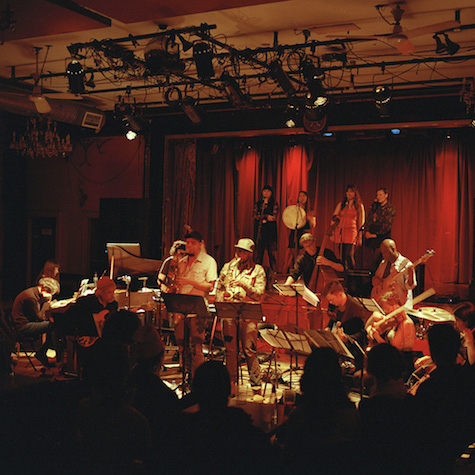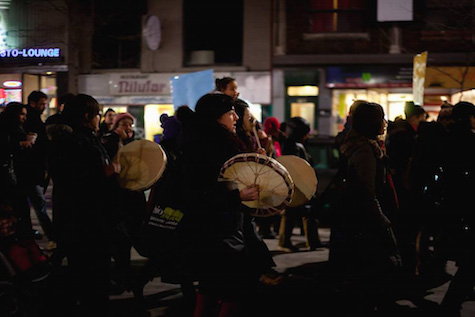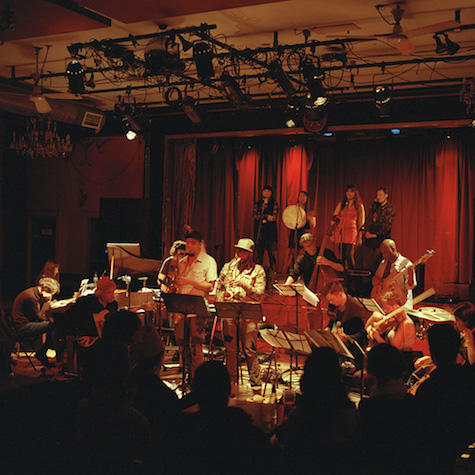Abstract
Odaya is an Indigenous feminist arts collective formed in 2007, incorporated as a non-profit organization in order to give funds raised from their performances back to the Indigenous communities of Montréal and elsewhere. This article will trace their experiences of collaboration as a musical group performing on the stage and at demonstrations on the street, along with their solidarity work focusing on Indigenous feminist community-building initiatives. Drawing upon interviews with members of Odaya, a discussion will centre on transformative cultural and political resistances through music, performance and collaboration.
Odaya is primarily known as an all-women traditional Native song and drum ensemble. While its members have learned and performed traditional songs from their own cultures, they have also written and performed their own traditionally-inspired songs as well as more experimental and improvisational work. Currently the group includes four women of mixed Indigenous heritage: Émilie Monnet (Anishinabe, French), Dayna Danger (Metis, Ojibway, Polish), Nahka Bertrand (Dene, Québecoise), and Anik Sioui (Wendat, Anishinabe, Franco-Canadienne). In an interview on Arts Nation by CUTV, Sioui explained the group's name, which comes from the Anishinabemowin word odemin, meaning strawberry and roughly translating as “the fruit of the heart.”1 The strawberry resembles a heart shape when cut and is a symbol of love and compassion for many Aboriginal peoples, thus the name was fitting for a group with a vision to contribute positively to Indigenous communities and to build bridges between different peoples.2
Indigenous feminist community-building: Resistance through collaboration
Originally composed of five women who met through working at the Québec Native Women Inc. association in Kahnawake, Émilie Monnet describes the context in which Odaya was formed:
We wanted to learn some songs and get teachings about the drum and at the time one of the eldest members of the group knew some songs, so it just started like that. The first time we sang publicly was for International Women's Day. It was a screening of Alanis Obomsawin's film, Waban-Aki: People From Where the Sun Rises. We were invited to sing for the opening. From then on we started to be invited. But at the beginning it was to feel connected, have a sense of community as Indigenous women in the city, and to get closer to our cultures.3
When Odaya started to receive invitations to perform at social justice gatherings and other events, they were unsure of what to do with the profits they made. They decided by consensus to reinvest all funds raised by Odaya into the community. Later they registered as a non-profit entity with a mandate to create and support various projects aimed at improving Aboriginal living conditions in Montréal and elsewhere. Monnet explained how their funds have been allocated:
We started by organizing a Christmas feast for Projets Autochtones du Québec, a shelter for Aboriginal homeless people in Montréal. So that’s how it started and it became a tradition… Another thing we did was to raise funds for a drum-making workshop at the Native Women’s Shelter.4
Bertrand met Monnet at the 2004 Indigenous People's Summit of the Americas in Buenos Aires and they studied theatre together for two years back in Montréal. She was approached by Monnet to participate in Songs of Mourning, Songs of Life (2012), co-produced by Monnet's Onishka Productions and Engrenage Noir/LEVIER. For the production, members of Odaya worked with the Atikamekw youth singing group Shining Stars from Wemotaci, and with Ihozo, a traditional Rwandan dance group to tackle themes of mourning and life renewal. Monnet describes the project as “a collaboration to look at the impacts of genocide on our communities and the role and power of the drum and song to heal collectively and individually.”5 A powerful meditation on sordid histories, Songs of Mourning, Songs of Life reclaims and resists colonial narratives by pointing towards a future of reconciliation full of cultural vibrancy, renewal and healing.
On April 24th 2014, Odaya collaborated with the renowned harpist Sarah Pagé, expanding their repertoire into more improvisational and experimental territory at a benefit concert for the Missing Justice Campaign for Missing and Murdered Indigenous Women as part of the Howl! Arts festival. Odaya again joined forces with the Howl! Arts Collective to collaborate with a diverse ensemble of 12 musicians collectively known as Regards sur le 7ème feu on October 31, 2014. The theme of the concert was based on the Anishinabe seven fires prophecy, which warns of choosing a path of environmental and technological destruction, greed and materialism over spirituality, respect and wisdom in compliance with the Earth's natural balance.6 During their collaboration with the musicians, Odaya members layered their vocals and added whispers, moans and guttural sounds to punctuate the cacophony of sound produced by the ensemble.7 Odaya's solo performance featured experimental drum techniques, including the tracing and scratching of drums, poetry, movement, audience participatory elements, and experimental vocalizations.
Odaya, solo performance with Regards sur le 7ème feu, October 31, 2014, La Sala Rossa, Montréal. Video: Marco Simonsen-Sereda. Permission of Marco Simonsen-Sereda.
Music as a weapon: Cultural preservation, innovation and resistance
Odaya has cultivated an interesting status as a group that moves fluidly between traditional and experimental sounds and performances. Bertrand commented on the complex nature of their work: “We all have polarities within us, all kinds of stuff. But I see this as sort of an expansion on the image of traditional Native women, we are actually not just bound to those stereotypes. So it’s showing another side of Odaya, and I think that’s very smart, very strong and very real.”8 Monnet also acknowledged that each member of Odaya is of mixed heritage, they all live in the city, and they are all influenced by their surroundings and individual musical preferences—all of this feeding into their work as inspiration.9 The activism and performances of contemporary Aboriginal artists such as Odaya run counter to Whitesupremacist colonial assumptions that Indigenous cultures are something of the past, to be preserved in a museum, isolated from modernity, or unchanging. In The Location of Culture, Homi K. Bhabha writes that, “An important feature of colonial discourse is its dependence on the concept of 'fixity' in the ideological construction of otherness.”10 Contemporary Indigenous writers, artists, organizers, and other cultural workers continue to refuse and resist stereotypes and racist thought through the weapon of culture.

Odaya performing in collaboration with Regards sur le 7ème feu, 2014, La Sala Rossa, Montréal. Photo: Võ Thiên Việt. Permission of Võ Thiên Việt.
Culture and identity are not static objects, fixed within the past; instead they involve dynamic, ongoing processes of negotiations and identifications that will respond to and reflect upon our lived realities. For example, at contemporary powwows there can be performances that may not be restricted to purely traditional elements. Danger discussed the limits of having definitive ideas of what is “traditional” at powwows in the broader cultural sense: “I think in order for our culture to survive, it has to change. It will inherently change. So with those kinds of limitations put on by Natives and also by non-Natives, there is a sense of preservation, but preservation really exists in experimentation and growth.”11 Danger also commented on the necessity of respecting the traditions and teachings that come with the songs they perform, as some of them should not be sung in public or be filmed, and that the teachings for songs are different for everyone, making it challenging to ensure protocols are respected.12
Monnet further underlined the importance of respecting indigenous cultural protocols: “To be able to do that, it just grounds you more in your identity or your roots, together as well.”13 In Bertrand's case, she views her work with Odaya as a form of cultural preservation for herself and her community: “I kind of see it as a ‘bringing back’ of something. In my case, my whole community went to residential school, there are no more songs and it was banned for a long time, they said it was the ‘devil’s music,’ and stuff like that, so people just stopped singing.”14 When asked if she had any Dene songs to contribute to Songs of Mourning, Songs of Life, and after finding that her family did not know any, she contacted Stephen Kakfwi, former premier of the Northwest Territories and Dene Nation President to see if he could send her some of his CDs, which he did the following day when he happened to be in Montréal. Bertrand's mother studied with Nicole Beaudry, an ethnomusicologist with the Dene people, so she was also given recordings of Dene songs from the 1970s. Bertand noted: “I feel that I might be able to carry these songs and then give them back to my community eventually.”15 The processes of reclaiming culture, building community, and resisting colonial narratives of Indigenous peoples is central to the work of Odaya.

Members of Odaya shown marching at the Annual Memorial March for Missing and Murdered Indigenous Women, February 14, 2014, Montréal. Photo: Võ Thiên Việt. Permission of Võ Thiên Việt.
For many years, Odaya has been invited to perform at the Annual Memorial March for Missing and Murdered Indigenous Women, a campaign they care about deeply. When asked about the experience of performing at a demonstration in comparison to the stage, Monnet described the importance for her of offering songs to the march and spoke of the nuances of each context:
With Odaya and when learning traditional songs, what I've learned is to sing loud. But it's different when you work with musicians and with microphones, you can express more subtleties in the voice, you have to be tighter. We’ve had to get singing lessons to help us with that, but I feel like at the March, it’s more about the intention and the energy of where we are at the moment. We are singing for the women.16
Monnet recently facilitated an audio workshop with Native participants as well as a few non-Native participants at OBORO, and the march and performances were recorded. Monnet stated that the project “was a reflection of presence of Aboriginal people or traces of Aboriginal history in the city through sound.”17 For other members like Bertrand, who considers herself a sensitive person, singing at protests can sometimes be quite emotionally draining.18 With the current climate of indifference fostered by the federal government regarding a national public inquiry into the deaths and disappearances of countless Indigenous women across Canada, events such as the annual march are crucial to create visibility and counter the inaction of Harper's conservative regime. Cree-Métis feminist scholar Kim Anderson has written about the importance of working to change the economic, social and political conditions for Indigenous women before any of the larger issues in Aboriginal communities can be addressed.19 The grief and anger can be stifling for many considering the emotional weight of this issue, but for Monnet, the march is not just about mourning. She concludes the interview on a more positive note:
Remembering elder John Cree’s words, he spoke of the importance to also laugh, to celebrate, to not just be mourning. We have to come together and we have to celebrate our presence, and not just be in that really heavy state. And celebrate the fact that so many people came even though it was so cold that day.20
Interview conducted in-person between Megan Mericle, Émilie Monnet, Nahka Bertrand and Dayna Danger in Montréal on February 24, 2015.
LINKS OF INTEREST
Justice for Missing and Murdered Indigenous Women
Video of Odaya and text from the event for Regards sur le 7ème feu on October 31, 2014 on
Võ Thiên Việt's photography blog
BIBLIOGRAPHY
Suzack, Cheryl, Shari M. Huhndorf, Jeanne Perreault, and Jean Barman, eds. Indigenous Women and Feminism: Politics, Activism, Culture. Vancouver and Toronto: UBC Press, 2010.
Bhabha, Homi K. The Location of Culture. London and New York: Routledge, 1994.
Conlon, Paula and Paul McKenzie-Jones. “Red Power: American Indian Activism through Powwow Music and Dance.” In Sounds of Resistance: The Role of Music in Multicultural Activism. Vol. 1: Activism in the United States. Edited by Eunice Rojas and Lindsay Michie. 21-45. Santa Barbara, Calif.: Praeger: 2013.
Coulthard, Glen Sean. Red Skin, White Masks: Rejecting the Colonial Politics of Recognition. Minneapolis: University of Minnesota Press, 2014.
Green, Joyce A, ed. Making Space for Indigenous Feminism. Black Point, N.S.: Fernwood Publishing; London, UK: Zed Books, 2007.
The Kino-nda-niimi Collective, ed. The Winter We Danced: Voices from the Past, the Future, and the Idle No More Movement. Winnipeg: ARP Books, 2014.
Maracle, Lee. I Am Woman: A Native Perspective on Sociology and Feminism. Vancouver: Press Gang Publishers, 1996.
Minh-Ha, Trinh T. Woman, Native, Other: Writing Postcoloniality and Feminism. Bloomington, Ind.: Indiana University Press, 1989.
Ullestad, Neal. “Native American Indian Rap and Reggae: Dancing to the beat of a different drummer,” In Ethnomusicology: A Contemporary Reader, edited by Jennifer C. Post. 331-349. New York: Routledge, 2006.
Notes
1Anik Sioui with Odaya, interview on Arts Nation, CUTV, October 28, 2013, https://www.youtube.com/watch?v=DRZ3j-py0PI.
2Ibid.
3Émilie Monnet with Odaya, interview with Megan Mericle, Montréal, February 24, 2015.
4Ibid.
5Ibid.
6The Shamanic Times.com, “Anishinaabe-Ojibwe: 'the Seven Fires,'” http://theshamanictimes.com/anishinaabe-ojibwe-indigenous-prophecies-2012.html.
7Regards sur le 7ème feu with Odaya, performance recorded by Marco Simonsen-Sereda on October 31, 2014, published on Dec, 27, 2014, digital video recording, https://www.youtube.com/watch?v=f1RcjxgQo-U.
8Nahka Bertrand with Odaya, interview with Megan Mericle, Montréal, February 24, 2015.
9Monnet, interview, Feb. 24, 2015.
10Homi K. Bhabha, The Location of Culture (London and New York: Routledge, 1994) 94.
11Dayna Danger with Odaya, interview with Megan Mericle, February 24, 2015.
12Ibid.
13Monnet, interview, Feb. 24, 2015.
14Bertrand, interview, Feb. 24, 2015.
15 Ibid.
16Monnet, interview, Feb. 24, 2015.
17Ibid.
18 Bertrand, interview, Feb. 24, 2015.
19Kim Anderson “Affirmations of an Indigenous Feminist,” in Indigenous Women and Feminism: Politics, Activism, Culture, 81-91 (Vancouver and Toronto: UBC Press, 2010) 85.
20Monnet, interview, Feb. 24, 2015.
Megan Mericle is a writer and artist currently studying French at Université du Québec à Montréal. She has a Master's degree in Art History from McGill University, and a BFA in Art from the University of Lethbridge (Alberta), where she grew up in Treaty 7 territory. Her MA research focused on the spectral dimension of time in the installation series Scenes from the House Dream by David Hoffos. She volunteers at organizations that promote social justice and combat food insecurity, and currently sits on the Board of Representatives of AMUSE, a union at McGill. In her spare time she works on her environmentally-based, socially-engaged art practice.

